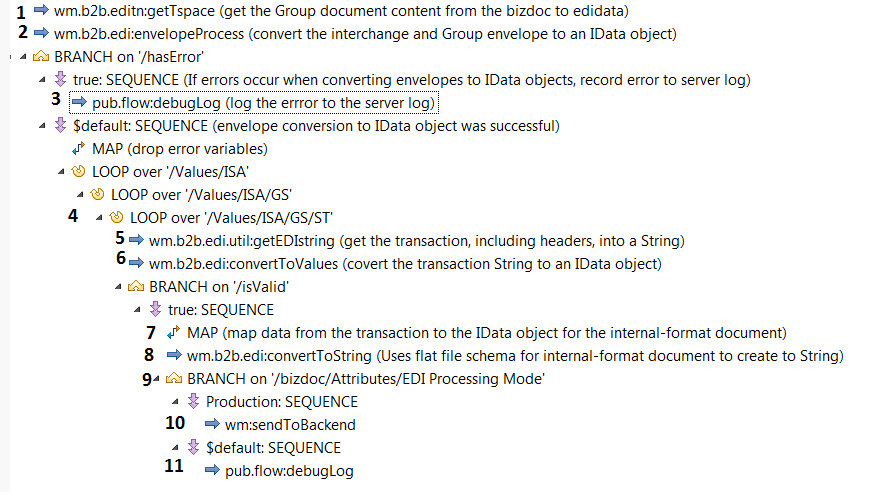

Flow operation | Description |
1 | Invoke the wm.b2b.editn:getTspace service to retrieve the content of the Group document from the BizDocEnvelope (in the bizdoc variable) to populate the edidata variable. You can use the getTspace service regardless of whether the document is considered large. For more information about getTspace, see webMethods Module for EDI Built-In Services Reference . |
2 | Invoke the wm.b2b.edi:envelopeProcess service to process the envelopes in the Group document. This service converts the interchange, group, and transaction set headers into an IData object named Values. The contents of the transaction sets remain unparsed. When setting the input variables to the envelopeProcess service, there is no need to validate or perform the compliance check on the Group document because the module already performs this validation during initial processing of the EDI document. For more information about envelopeProcess, see webMethods Module for EDI Built-In Services Reference . |
3 | If the wm.b2b.edi:envelopeProcess service returns errors, invoke the wm.pub.flow:debugLog service to log a message to the server log. |
4 | Loop through the transaction set headers. Note that a Group document contains only a single interchange and a single group header. The data for the transaction set headers is within the Values IData object: |
Flow operation | Description |
5 | Invoke the wm.b2b.edi.util:getEDIstring service to convert the transaction set header and trailer back to a string and concatenate them with the transaction set contents. The resulting transaction set with header and trailer can be either a String or InputStream object. For more information about the wm.b2b.edi.util:getEDIstring service, see webMethods Module for EDI Built-In Services Reference . You must have an element that contains the entire transaction set, including header and trailer, before you can invoke the next service, wm.b2b.edi:convertToValues. This is because convertToValues uses a flat file schema for the EDI transaction set that includes the transaction set header and trailer. If you input data without the header and trailer, convertToValues returns errors. |
6 | Invoke the wm.b2b.edi:convertToValues service to: The inputs to the convertToValues service include the flat file schema for the EDI transaction. convertToValues uses the flat file schema to determine how to parse the transaction set into an IData object and validate its structure. For more information about convertToValues, see webMethods Module for EDI Built-In Services Reference . |
7 | Map the data from the EDI transaction set into the internal format. Now that the contents of the transaction set are an IData object, you can access the data in the transaction set to map it to an IData object for the internal-format document. Depending on the complexity of your mapping requirements, you might need to add more logic than a MAP flow operation, or create a separate service to perform the mapping. |
8 | Invoke the wm.b2b.edi:convertToString service to convert the internal-format document from an IData object to a String. The inputs to the convertToString service include the IData object, which contains the data and the flat file schema for the document in internal format. convertToString uses the flat file schema to determine how to form the internal-format document. convertToString can also use an IS document type to define the structure of the internal-format document. For more information about convertToString, see webMethods Module for EDI Built-In Services Reference . |
9 | Branch based on the value of the EDI Processing Mode custom attribute. This attribute is in the bizdoc/Attributes/EDI Processing Mode variable. Module for EDI sets the value of the EDI Processing Mode custom attribute based on the setting of the EDITPA processingMode variable. For more information, see processingMode Variable. |
10 | If the value of the EDI Processing Mode custom attribute is: |